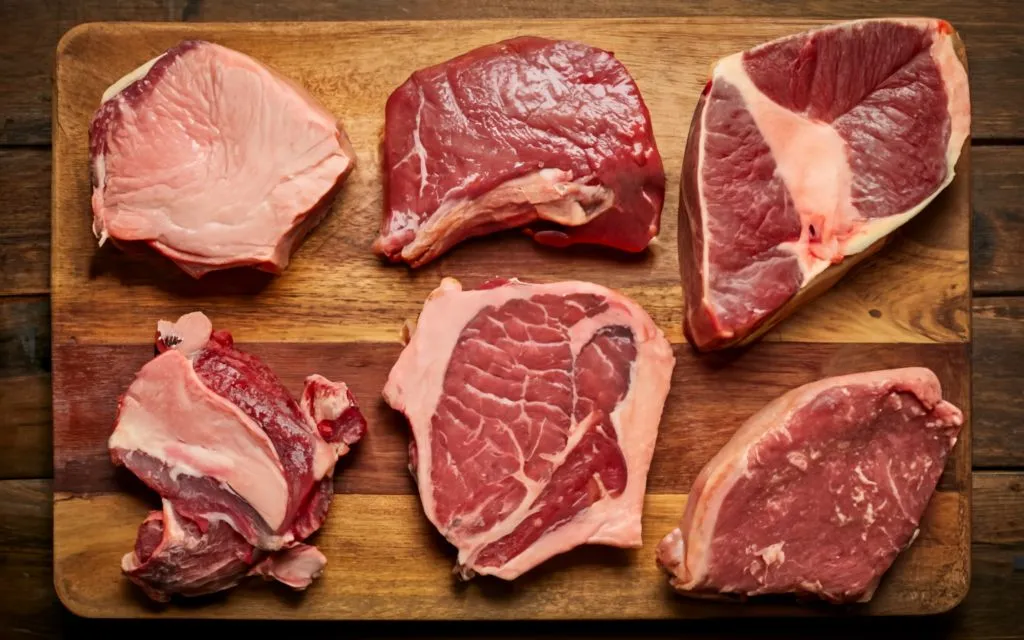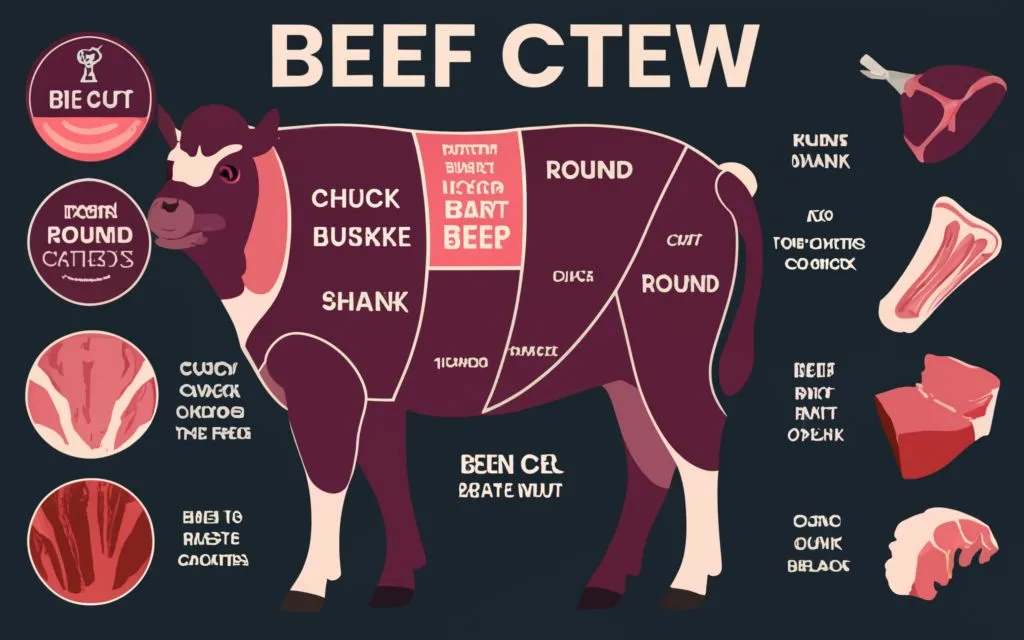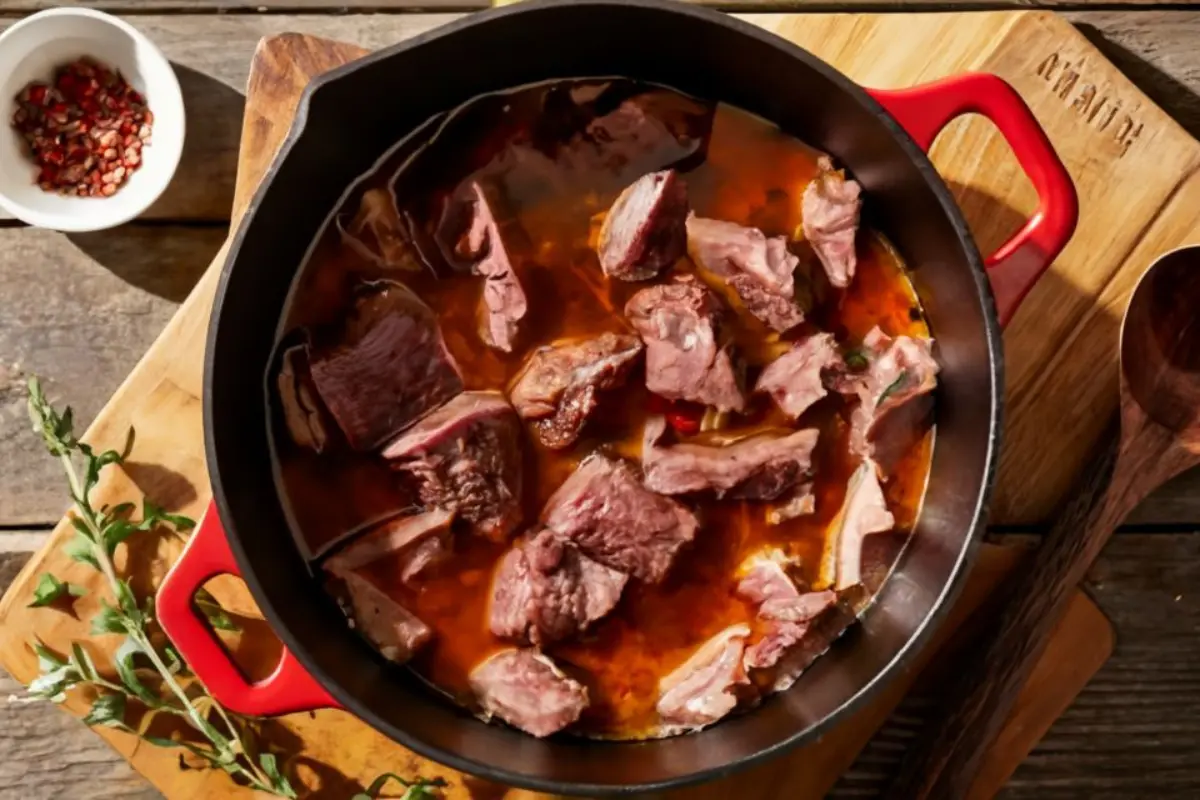Exploring Ideal Beef Stew Cuts

Diving into the world of beef stew, it’s clear that some cuts are simply cut out for this job more than others. The secret? It’s all in the connective tissue and marbling. These cuts, when cooked slowly, break down beautifully, enriching your stew with flavors and textures that are nothing short of spectacular. Read more: Flap Meat Unveiled
Selecting the Best Beef for Stew
Choosing the right stew beef is like picking the perfect teammate; it’s crucial for victory. You want a cut that’s not only rich in flavor but also has the resilience to withstand slow cooking without turning tough. The chuck roast, with its perfect mix of fat and connective tissues, is often hailed as the MVP in the world of beef stews. It’s that recommended stew beef variety that chefs and home cooks swear by, thanks to its ability to become incredibly tender and flavorful over time.
But why stop at just knowing the cuts? Let’s delve deeper into why these cuts stand out and how you can prepare them to ensure your beef stew is the talk of the table. Stay tuned as we break down the art of selecting, preparing, and cooking the ultimate beef stew, ensuring every bite is a testament to your culinary prowess. Read more: Mastering Flap Meat
Best Beef Cuts for Stew

Chuck: The Ultimate Stew Beef
When pondering over what cut of beef is stew meat, the chuck roast immediately springs to mind. Harvested from the shoulder area, this cut is the gold standard for stews. Why, you ask? Well, it’s marbled with fat and riddled with connective tissues that melt like magic during slow cooking, infusing the stew with rich flavors and a melt-in-your-mouth texture. Moreover, chuck is not just about taste; it’s also about the stew becoming a comforting bowl of joy, thanks to its tender consistency.
Round: A Leaner Stew Option
Now, if you’re leaning towards a healthier option, the round cut is your go-to. Sourced from the hindquarters, it’s leaner than chuck but still packs a punch in the flavor department. However, it’s a bit of a tricky player. To avoid it turning into a chewy disappointment, it demands a careful, slow-cooking approach. But get it right, and you’ve got yourself a stew that’s both nutritious and delicious.
Alternative Stew Beef Varieties
And let’s not forget, there are other players in the game. Brisket and shank, for instance, might not be the first cuts that come to mind, but they’re worth considering. Each brings its unique texture and flavor to the table, offering a delightful twist to your traditional stew recipe.
In essence, the journey to a heartwarming beef stew starts with selecting the right cut. Whether you opt for the classic chuck, the leaner round, or venture into the realms of brisket and shank, each choice plays a pivotal role in the stew’s final taste and texture. So, next time you’re at the butcher’s, remember, the cut you choose is the foundation of your stew’s success. Read more: Wholey Beef Cuts Guide
Preparing Your Beef for Stew
Choosing the Right Stew Beef
Selecting the right beef for your stew is paramount. After all, not every cut will do when you’re aiming for that perfect blend of tenderness and flavor. So, when faced with the question, What cut of beef is stew meat? remember, the chuck and round cuts are often your best bets. However, the key lies in knowing how to prepare them to bring out their best qualities in your stew. Read more: How to Cook Flap Meat
How to Cut Beef for Stew
Once you’ve got your hands on the ideal cut, the next step is to prepare it properly. Start by cutting the beef into uniform pieces. This ensures that every bite cooks evenly and soaks up the stew’s savory flavors. Additionally, trimming off excess fat can help balance the richness of the dish, although leaving some fat on is crucial for that mouthwatering juiciness.
In essence, the preparation phase is where your stew starts to take shape. By selecting the right cut and preparing it with care, you’re laying the foundation for a stew that’s not just a meal, but an experience. So, take your time with this step. After all, good things come to those who wait, and a great beef stew is definitely worth the wait.
Tips for a Perfect Beef Stew

Crafting the perfect beef stew is an art that goes beyond just choosing what cut of beef is stew meat. It’s about mastering the slow cooking process and seasoning to elevate the flavors of your chosen cut to new heights.
Techniques for Slow Cooking Beef
Slow cooking is the heart and soul of a great beef stew. This method ensures that the beef, especially tougher cuts like chuck, becomes tender and succulent. Start with a low and slow approach, allowing the beef to simmer gently. This not only tenderizes the meat but also allows the flavors to meld together beautifully, creating a rich and complex base for your stew.
Moreover, consider browning your beef pieces before adding them to the stew. This extra step adds depth to the flavor, introducing a caramelized texture that can’t be achieved through simmering alone. Remember, patience is key here; good things come to those who wait, and a perfect beef stew is no exception.
Enhancing Your Stew with Seasonings
Seasoning is what brings your stew to life. Beyond the basics of salt and pepper, incorporating herbs like rosemary, thyme, and bay leaves can add a layer of aromatic complexity that complements the beef wonderfully. Don’t shy away from experimenting with a splash of red wine or a dash of Worcestershire sauce for an added flavor kick. These ingredients not only enrich the stew but also help to tenderize the beef further, making each bite a delight.
In conclusion, achieving the perfect beef stew is about more than just simmering meat and vegetables. It’s a careful balance of selecting the right cut, employing slow cooking techniques, and layering flavors through thoughtful seasoning. With these tips in mind, you’re well on your way to creating a stew that warms the heart and soothes the soul.
Beyond Beef: Other Stew Options
While beef is the traditional star of the stew, exploring other meats and even non-meat alternatives can offer delightful variations to this classic dish. This exploration not only caters to different dietary preferences but also introduces a range of flavors and textures to your culinary repertoire.
Exploring Different Meats for Stew
Venturing beyond beef opens up a world of possibilities. Lamb, with its rich, gamey flavor, makes for a robust stew, especially when paired with root vegetables and fresh herbs. Pork, another versatile option, lends a tender quality to stews, absorbing flavors while contributing its own subtle sweetness. Chicken, particularly thighs and legs, can also be used for a lighter stew, offering a leaner but equally satisfying alternative.
Moreover, for those curious about less common meats, venison and bison offer unique tastes and are worth exploring. These meats, known for their lean texture and distinctive flavors, can elevate a simple stew into a gourmet experience.
Meat-Free Alternatives for Stew
For vegetarians and vegans, or simply for those looking to reduce meat consumption, there are plenty of meat-free alternatives that still promise a hearty stew. Mushrooms, with their umami-rich profile, stand out as a popular choice, mimicking the texture and depth of beef. Legumes, such as lentils and chickpeas, not only thicken the stew but also provide a protein-packed punch. Root vegetables, like carrots, parsnips, and potatoes, add body and sweetness, absorbing the flavors of the broth beautifully.
In essence, the question of what cut of beef is stew meat? opens the door to a broader inquiry into what makes a stew truly satisfying. Whether you stick with traditional beef or explore other meats and meat-free options, the key to a great stew lies in the balance of flavors, textures, and, of course, a touch of culinary creativity.
FAQs

Choosing the Right Cut
- What makes chuck the ideal choice for stew meat? Chuck earns top marks as the go-to stew meat because of its fat and connective tissue. These melt during cooking, tenderizing the meat and enriching the stew with flavor. Plus, it’s both versatile and cost-effective.
- Can frozen beef be used in stew? Yes, indeed. Using frozen beef is perfectly fine. Thawing it first, preferably in the fridge, ensures even cooking and optimal flavor absorption. Remember, good stew starts with good prep.
Cooking Techniques
- What’s the best cooking duration for beef stew? Typically, beef stew needs about 2 to 3 hours of slow simmering on low heat. This method ensures the meat becomes tender and the flavors meld. In a slow cooker, aim for 6 to 8 hours on low or 4 to 5 hours on high.
- Are there quick-cooking beef cuts suitable for stew? For a quicker stew, leaner cuts like sirloin or tenderloin can be used, but they lack the richness of chuck or round. Quick-sear these cuts and combine them with pre-cooked veggies for a speedy stew.
Enhancing Flavor and Texture
- How can I thicken my beef stew? To thicken stew, a flour or cornstarch slurry works wonders. Alternatively, mashing some stew vegetables and stirring them back in can also do the trick. For a more concentrated flavor, let the stew simmer uncovered for the last 30 minutes.
Conclusion: Unveiling the Secret to Hearty Stews
Discovering the Ideal Cut
At the heart of every memorable stew lies a pivotal choice: What cut of beef is stew meat? Our journey reveals that while chuck is often celebrated for its ability to tenderize beautifully over slow cooking, the essence of stew transcends the cut itself. It’s about the blend of flavors, the cooking process, and the joy it brings.
Beyond the Beef
Furthermore, this exploration into stews has broadened our culinary horizons. Whether opting for beef or venturing into alternative meats and plant-based options, the adventure in stew making is limitless. It encourages innovation, inviting each cook to imprint their unique signature on the dish.
A Parting Thought
In essence, the perfect stew is more than its ingredients. It’s a vessel for warmth, comfort, and connection. As you ponder what cut of beef is stew meat?, also consider the moments and memories that will simmer alongside your stew. After all, the best dishes are those that nourish both body and soul.

